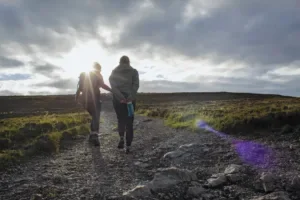The Harry Ransom Center, a humanities research library and museum at The University of Texas at Austin, has introduced the Web exhibition “Sanora Babb: Stories From the American High Plains,” which highlights the work of American novelist Sanora Babb (1907-2005). Babb drew on the natural beauty of the American High Plains and the difficult conditions of her childhood there to give voice to a people who left little written record of their own lives and who have received scant representation in history.

The exhibition highlights Babb’s accomplishments as a fiction writer and illustrates with historical photographs the plight of Depression-era Americans. Many of the photographs were taken by Babb’s sister, Dorothy.
The exhibition features materials from the Center’s Sanora Babb collection. The collection, which is composed of about 90 boxes, was donated to the Ransom Center in six batches between 2000 and 2008. The materials will be accessible to researchers once organized and housed.
Babb was born in Oklahoma. Her family moved frequently during her childhood before settling on a farm in the High Plains of southeastern Colorado, living in a dugout homesteaded by her grandfather. After repeated crop failures, the Babbs moved first to Elkhart, Kan., then to Forgan in the Oklahoma Panhandle, where Sanora graduated as valedictorian of her high school class. She spent a year at the University of Kansas but returned home when her funds ran out, graduating from the Garden City Junior College in 1926.
After working as a teacher, journalist, radio script writer and editorial assistant for the English magazine The Week, Babb joined the Farm Security Administration (FSA) as assistant to manager Tom Collins, setting up tent camps for the dispossessed in California’s agricultural valleys. Her FSA work furnished material for her first novel, “Whose Names Are Unknown,” which traces the lives of High Plains families uprooted from their dry land farms, forced to seek work as seasonal harvesters. Random House accepted Babb’s novel for publication in 1939, then broke the contract when John Steinbeck’s “The Grapes of Wrath” appeared, contending that buyers would not welcome two novels treating the same subject. “Whose Names Are Unknown” was eventually published by University of Oklahoma Press in 2004 to much acclaim, including a Los Angeles Times review claiming that Babb’s Dust Bowl novel rivaled Steinbeck’s “The Grapes of Wrath.”
While both novels deal with the Dust Bowl exodus, they contrast in their interpretation of the tragic events of dispossession and refugee status in the 1930s. Steinbeck created a fable-like novel that uses structurally figurative means to represent the condition of the “Okies.” “Whose Names Are Unknown,” on the other hand, hews close to testimonial witnessing, revealing an immediate, intimate world of human relationships.
Growing up on the High Plains in poverty, sisters Sanora and Dorothy Babb knew intimately the aspirations, failed dreams and struggle for dignity that were the experience of the people eking out a living through the Dust Bowl. Both sisters shared literary interests, but only Sanora succeeded in shaping a career as a journalist and novelist. Dorothy, however, left a remarkable legacy of 250 photographs documenting the Dust Bowl refugees. The sisters each captured what they saw-one with her camera and one with words.
“Drawing from her memories of the High Plains in her three novels, 50 short stories and 30 poems, Sanora Babb constructed a collective memory of place, a lived world that delineated the components of space and place in the yawning, limitless vastness of the High Plains, that functions as both a cultural history for a community of people linked by circumstances of time and place and as a transmitter of memory to readers unfamiliar with these circumstances,” said Douglas Wixson, curator of the Web exhibition, professor emeritus at the University of Missouri-Rolla and Babb biographer. “Her writings dramatize the growth and development of individual consciousness engaged in a communal and ecological life-world. They serve to foreground and dignify the ordinary and give expression to timeless social injustices such as homelessness, poverty, discrimination, inequality, economic hardship and repression of dissent.”
After Random House failed to publish her novel, Babb was the West Coast secretary of the League of American Writers and edited The Clipper in the early 1940s, and its successor, The California Quarterly, a decade later, introducing American readers to the work of B. Traven, author of “The Treasure of Sierra Madre,” the French colonial poets Aimé Césaire, Léon Damas and Jean Joseph Rabéarivélo, and promising young writers like Ray Bradbury.
Babb moved to Mexico City during the early years of the House Committee on Un-American Activities investigations, when her connections with the cultural left threatened the career of her husband, Chinese-American cinematographer James Wong Howe. Babb and Wong Howe had lived together, flouting anti-miscegenation laws until California’s ban on interracial marriages was overturned in 1948 and they were permitted to marry.
Babb wrote short stories about impoverished Mexican workers she had come to know and drafted the manuscript of her second novel, “The Lost Traveler” (1958).
Returning to Los Angeles, she continued to write and publish well into her 80s. In the 1950s and ’60s she met regularly with a writers’ group that included Bradbury, Esther McCoy, Sid Stebel, Bonnie Barrett Wolfe, C. Y. Lee, Peg Nixon, Richard Bach and Dolph Sharp.
Other publications include the novel “An Owl on Every Post” (1971), a collection of short stories titled “The Cry of the Tinamou” (1997) and a book of poems, “Told in the Seed.” Preceded in death by her sister Dorothy in 1995, Sanora died at age 98 in 2005 at her home in Hollywood, Calif.



